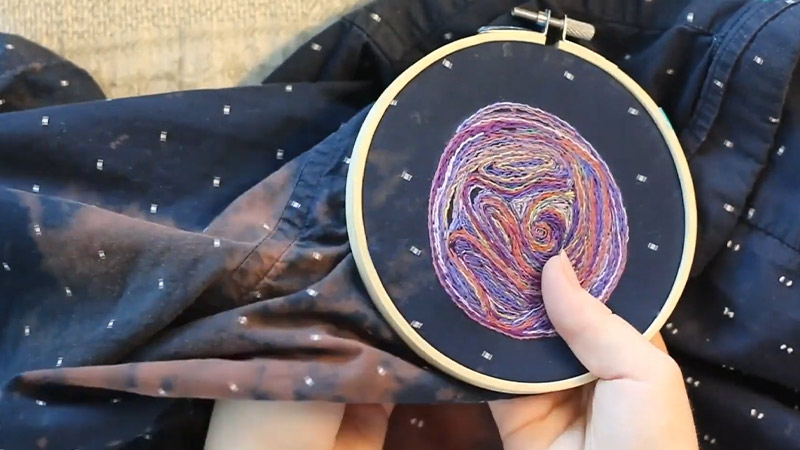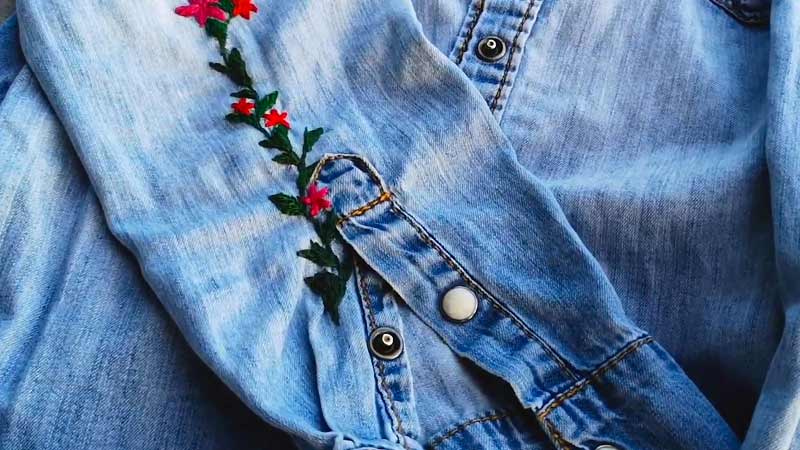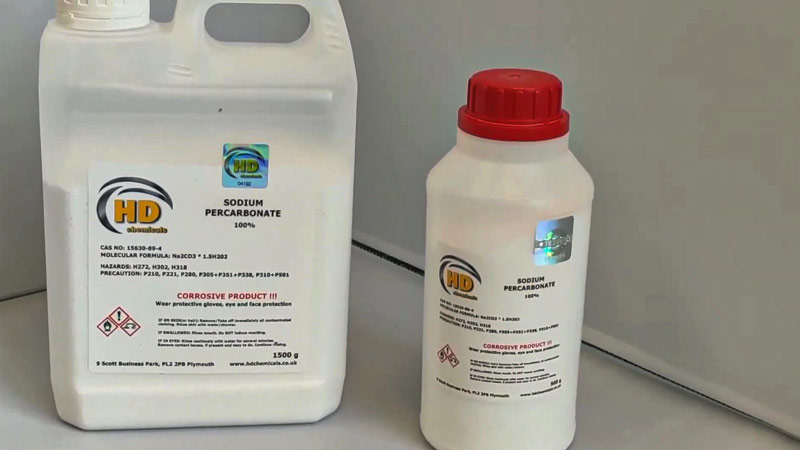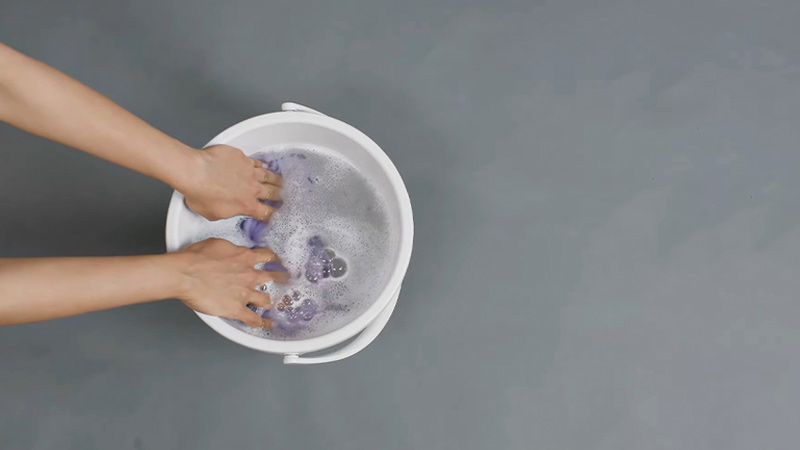Embroidery, an exquisite art form that graces fabrics with intricate designs, holds a timeless allure. As we strive to maintain the longevity of our embroidered treasures, questions arise about common household practices, and one such concern revolves around using bleach.
Will bleach ruin embroidery fabric color as it’s a potent cleaning agent? This inquiry delves into the potential risks and precautions associated with using bleach on embroidered items.
Join us on a journey to unravel the mysteries surrounding this cleaning agent and its impact on the meticulous craftsmanship of embroidery.
By embracing informed care practices, we can extend the life of our embroidered treasures, ensuring they continue to narrate stories through their stitches.
Whether it’s a cherished heirloom or a contemporary piece, understanding the dynamics between bleach and embroidery is crucial for preserving stitches’ aesthetic charm to our fabric canvas.

Will Bleach Ruin Embroidery?
When you wash embroidered clothes, you might wonder whether you can bleach embroidery thread. Let’s understand both the nature of embroidery and the properties of bleach and find out if it’s okay to bleach thread.
Nature of Embroidery
Embroidery, with its intertwining threads and detailed stitches, elevates fabrics into expressions of creativity and cultural significance.
Whether it’s an heirloom passed down through generations or a contemporary piece, the delicate nature of embroidery demands careful consideration when it comes to cleaning and maintenance.
Nature of Bleach
On the other hand, Bleach is a powerful disinfectant known for eliminating stains and bacteria. However, its potency raises concerns about potential damage to delicate fabrics and intricate embroidery.
To unravel this cleaning agent’s mysteries and its impact on embroidered items, let’s explore the dynamics between bleach, embroidery, and related risks.
Potential Risks to Embroidery
The answer to whether you can bleach embroidery depends on the type and color of the fabric. Here are the potential risks of bleaching embroidered clothes:
Color Fading
Bleach is notorious for its ability to strip away colors. Vibrant threads that contribute to the visual richness of embroidery may lose their brilliance when exposed to bleach, resulting in a faded and dull appearance.
Thread Damage
The chemical reaction between bleach and certain types of threads can compromise their integrity. Weakened threads are more prone to breakage, unraveling the very essence of the embroidered design.
Loss of Texture
Intricate textures created through various stitching techniques may be altered by bleach exposure. The subtle interplay of raised and flat surfaces could be disrupted, diminishing the tactile beauty of the embroidery.
Fabric Weakening

Beyond the impact on threads, bleach can weaken the fabric itself. This weakening may manifest as thinning or distortion, affecting the overall structure of the embroidered piece.
Introduction of Stain Residue
While aiming to remove stains, bleaching embroidered items can inadvertently introduce a new concern – the potential residue left behind. In the process of battling stubborn stains, bleach may leave subtle marks or discolorations on the fabric.
This unintended consequence can create a new visual disturbance, marring the pristine surface of the embroidery. So, does bleach damage clothes? Yes, if it leaves unwanted stains.
Impact on Embellishments
Embroidered pieces often feature embellishments like beads, sequins, or metallic threads. These embellishments contribute to the opulence of the design.
However, bleach poses a risk to these elements, potentially tarnishing metallic threads or affecting the luster of beads and sequins.
Mitigating Risks and Best Practices
While the potential risks of using bleach on embroidery are evident, there are measures to minimize these concerns and preserve the integrity of embroidered items.
Dilution
Diluting bleach with water reduces its potency, minimizing the risk of color fading and structural damage. Testing the diluted solution on a small, inconspicuous area of the embroidery allows for assessing its impact.
Spot Treatment
Consider spot-treating specific stains or areas rather than submerging the entire embroidered piece. This targeted approach allows for controlled bleach application, reducing the likelihood of widespread damage.
Alternative Cleaning Methods
Explore alternative cleaning methods, such as gentle hand washing with mild detergents or specialized fabric cleaners. These methods provide effective cleaning without the harsh effects associated with bleach.
Professional Cleaning
For valuable or intricate embroidered items, seeking professional cleaning services may be the safest option. Professional cleaners have the expertise to assess fabrics and employ suitable cleaning techniques.
How to Bleach Colored Clothes without Ruining Them?
Preserving the integrity of colored clothes while incorporating bleaching techniques demands a delicate balance.
Bleaching can be a powerful tool for reviving faded hues or removing stubborn stains, but the process requires careful consideration to avoid ruining the vibrancy and structure of the garments.
Here’s a comprehensive guide on bleaching colored clothes without compromising their beauty.
Choose the Right Bleach

When bleaching colored clothes, opt for oxygen bleach or color-safe bleach rather than chlorine bleach.
Oxygen bleach is gentler on fabrics and colors, making it a safer choice for maintaining the vibrancy of your garments. Ensure the bleach is labeled as color-safe or suitable for use on colored fabrics.
Read Care Labels
Before embarking on the bleaching journey, consult the care labels on your colored clothes. These labels provide valuable information about the fabric composition and recommended care instructions.
Following these guidelines ensures that you choose an appropriate bleach method for each garment.
Spot Test
Perform a spot test on a small, inconspicuous area of the garment to assess how the fabric reacts to the bleach. This precautionary step helps you avoid unintentional damage or discoloration to the entire garment. If the spot test yields satisfactory results, proceed with the bleaching process.
Dilution is Key
Dilute the bleach according to the instructions on the product packaging. Avoid using undiluted bleach on colored clothes, as this increases the risk of color fading and fabric damage. Dilution ensures a milder impact while still effectively tackling stains or restoring color.
Pre-soak Method
For overall color refreshment or stain removal, consider a pre-soak method. Fill a basin or sink with cold water and add the diluted bleach.
Submerge the colored clothes in the solution and let them soak for a limited time, usually around 15-30 minutes. Monitor the process to prevent over-bleaching.
Hand Wash Technique

Hand washing provides a more controlled approach to bleaching colored clothes. Use a gentle detergent along with the diluted bleach solution.
Gently agitate the water to ensure even distribution of the bleach. Rinse thoroughly with cold water after the desired bleaching duration.
Spot Bleaching
Target specific stains or areas with spot bleaching. Apply the diluted bleach directly to the stain using a sponge or cloth.
Gently rub the area, allowing the bleach to penetrate the stain without affecting the surrounding fabric. Rinse thoroughly after stain removal.
Avoid Prolonged Exposure
Limit the exposure of colored clothes to bleach. Prolonged soaking or extended contact with bleach can lead to excessive color fading and fabric damage.
Follow the recommended pre-soaking or spot-bleaching time frames to strike the right balance.
Neutralize with Vinegar
After bleaching, neutralize the garments by adding white vinegar to the rinse water. This helps remove any residual bleach and prevents further chemical reactions. Rinse thoroughly with cold water to ensure all traces of bleach are eliminated.
Machine Washing Considerations
If using a washing machine, add the diluted bleach to the water before loading the colored clothes. This ensures even distribution and reduces the risk of concentrated bleach coming into direct contact with the fabric. Use a gentle cycle with cold water to minimize agitation.
Dry with Care
Air-dry the bleached-colored clothes instead of using a dryer. High heat can exacerbate color fading and compromise the fabric’s structure. Hanging or laying the garments flat to dry helps preserve their vibrant hues and overall quality.
Regular Maintenance
Implementing regular fabric care practices contributes to the longevity of colored clothes. Wash them with like colors, turn them inside out to reduce friction, and avoid excessive sun exposure, which can contribute to color fading over time.
FAQs
Can I bleach a white shirt with colored embroidery?
Bleaching a white shirt with colored embroidery requires careful consideration. While bleach is generally suitable for white fabrics, the colored threads in the embroidery may be vulnerable. To minimize risks, use a color-safe bleach or a diluted bleach solution.
Does bleach ruin towels?
Bleach can impact towels, and caution is advised. Using bleach on colored or patterned towels may cause color fading or damage.
For white towels, opt for color-safe bleach or dilute regular bleach. Follow care label instructions, avoid prolonged exposure, and rinse thoroughly.
How can I bleach white clothes without fading them?
To bleach white clothes without fading them, use color-safe bleach or dilute regular bleach according to the product’s instructions.
Avoid using undiluted bleach, as it can lead to fabric damage and color fading. Implement a pre-soak or spot treatment method, following recommended time frames.
Can I use bleach on dark-colored fabrics?
Bleaching dark-colored fabrics requires caution, as bleach can cause significant color fading. Consider alternative cleaning methods to avoid compromising the richness of dark hues. Use oxygen bleach or color-safe bleach specifically designed for dark fabrics if necessary.
How do I remove stains from colored clothes using bleach?
Removing stains from colored clothes with bleach demands a gentle approach. Choose color-safe bleach or oxygen bleach. Dilute the bleach according to instructions and perform a spot test. Apply the diluted solution directly to the stain for spot bleaching, gently rubbing the area.
Conclusion
In this delicate dance between cleanliness and preservation, our exploration into whether bleach can mar the beauty of embroidery reveals a nuanced interplay.
While bleach carries the potential to erase vibrant hues and weaken threads, strategic precautions can mitigate these risks.
As custodians of embroidered elegance, adopting alternative cleaning methods or employing diluted bleach solutions emerges as a safeguard.
The key lies in striking a balance between hygiene and preserving intricate designs. Our guide will help you properly care for your embroidered clothes and protect them from all types of damage.
So, as we bid adieu to misconceptions and welcome careful consideration, let us tread lightly on the path of maintenance, allowing the artistry of embroidery to flourish and endure, unblemished by the harsh effects of bleach.
In this delicate equilibrium, our cherished embroidered pieces can thrive for generations to come.
Leave a Reply